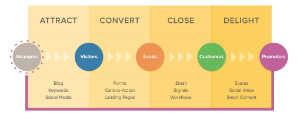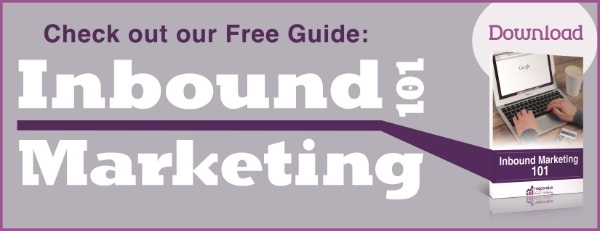Inbound marketing has been the most effective marketing method for doing business online since 2006 (HubSpot), so something must be working. Here, we’ll delve into exactly what, and why. What is happening down the buyer’s journey that is turning strangers into visitors, then visitors into leads, leads into customers, and finally, customers into promoters – people who not only want what you’re selling, but are delighted by the idea so much that they’ll spread the news? A little thing called effective inbound marketing.
Unlike traditional outbound marketing tactics like buying ads, buying email lists, and praying for leads, inbound marketing is centered on pulling people where they naturally want to be, which makes sense because your customers should and will be people who love your company and product. By aligning the content you publish with your customers’ interests, you naturally attract inbound traffic that you can then convert, close, and please over time. When your content is specifically designed to appeal to your dream customers, you’re attracting qualified prospects to your business and keeping them coming back for more. The right content at the right place at the right time is the type of marketing that people love.
It’s important to acknowledge that inbound marketing doesn’t just happen; you do it. So, how do you attract visitors, convert leads, close customers, and delight promoters? Let’s start with ways to attract:
-
Blogging - Attract new visitors to your website with educational content.
-
SEO - Pick keywords, optimize your pages, create content, and build links around the terms your ideal buyers are searching for.
-
Pages - Optimize your website with helpful content to entice the right strangers to visit your pages.
-
Social Publishing - Share valuable information on the social web, engage with your prospects, and put a human face on your brand in the networks where your ideal buyers spend their time.
Then, convert with:
-
Forms - Visitors become leads after they fill out a form and submit their information.
-
Calls-to-Action - Include buttons or links that encourage your visitors to take action so you can generate leads.
-
Landing Pages - This is where a visitor is sent after they click a on call-to-action and where the call-to-action is fulfilled. Then, the visitor becomes a contact.
-
Contacts - Keep track of leads in a central marketing database so you can make sense out of every interaction you’ve had with your contacts.
Next, close using:
-
CRM - (Customer Relationship Management) Keep track of the details about all the contacts, companies, and deals in your pipeline, and easily get in touch with the right prospects at the right time.
-
Closed-loop Reporting - Analyze just how well your marketing and sales teams are playing together.
-
Email - A series of emails focused on useful, relevant content can build trust with a prospect and help them become more ready to buy.
-
Marketing Automation - Create email marketing and lead nurturing tailored to the needs and lifecycle stage of each lead.
And finally, delight with:
-
Surveys - Use feedback and surveys to ensure you’re providing customers with what they’re looking for.
-
Smart Calls-to-Action - Present different users with offers that change based on buyer persona and lifecycle stage.
-
Smart Text - Provide your existing customers with remarkable content tailored to their interests and challenges. Help them achieve their own goals, as well as introduce new products and features that might be of interest to them.
-
Social Monitoring - Keep track of our customers’ questions, comments, likes, and dislikes and reach out to them with relevant content.
So, now you know what inbound marketing means, why it’s proven successful, and even how it’s done. The next step is trying it out on your brand!
